London Road Station a heritage asset
Now on The Council's local list
Good news: the lovely station was added to our city's revised Local List of Heritage Assets.
See the new listing adopted on 18th June 2015.
Many thanks to associatiions [DRARA / Southdown Rise / The Round Hill Society], ward councillors and individual residents who made this happen by supporting the nomination.
Go to The Council's web page at www.brighton-hove.gov.uk/content/planning/heritage/local-list-heritage-assets to see what else is now on the recently approved list.
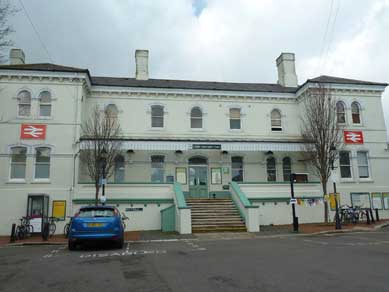
Asset Address: Shaftesbury Place, Brighton, East Sussex BN1 4QS
Asset Type (e.g. Pub/House/Public Park): Railway station (with public right of across it)
Date of Construction: 1877
Short Description of Asset (e.g. materials, style, features of interest)

London Road Station is our city's best example of Italianate style favoured by the railway architects of the mid-Victorian era. The station itself is distinguished as you enter from the south by its flight of steps leading from the pavement to the booking hall flanked on each side by attractive balconies.
As you emerge from booking hall to platform 1, there is a definite rural-feel since the two platforms of London Road Station are staggered.

Among the city's railway stations already listed, are Brighton (Grade II listed on 30 April 1973), Hove and Portslade. However, the platforms of these stations run in parallel i.e. they do not offer the amenity of attractive railway corridor open space, rich wildlife habitat right opposite platform 1.

How does the nominated asset meet the criteria for Architectural, Design and Artistic interest?
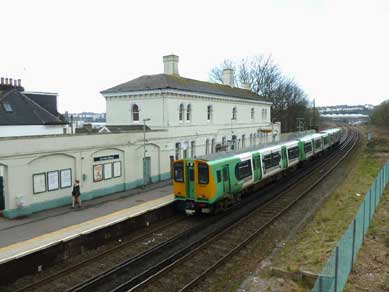
The siting of London Road Station and its rural setting make it our city's most attractive example of Italianate style favoured by the railway architects of the mid-Victorian era. Other local stations (Hove, Kemp Town and Portslade) shared what was in the 1870s a standard design. The other surviving railway stations, Hove and Portslade, which have more industrial settings, are already listed.
London Road Station blends well with the adjoining neighbourhoods. Note the arched window-types and the use of wooden sash window frames in the following views, the slate roof and the detailing along the eaves of the station building. The Italianate architectural style is best appreciated from the south on the approach up steep steps to the ticket hall.
From the north east 

From the east 
From the south west 

From the south 

How does the nominated asset meet the criteria for Historic and Evidential Interest?
A place often becomes important to different generations of resident because of its associations (e.g. the Cavern Club in Liverpool & The Beatles)
The railway history of Brighton 
Firstly, London Road Station evokes the Victorian history of Brighton. It is the first stop east of Brighton and was the last stop before the junction of The Kemp Town Branch Line. 
For many years, it provided a rail link with Round Hill at the junction of Richmond Rd & D'Aubigny Rd (the location of Lewes Road Station) and also with Hartington Road Halt (after the Lewes Rd Viaduct) and Kemp Town Station (after the tunnel under Elm Grove).
On London Road Station’s doorstep directly to the south of the main entrance is the thriving Signalman public house. The building still bears its previous identity as The Railway Hotel.
As “The Signalman”, this continues the tradition, prevalent still in The New England Quarter, of naming local pubs after railway-related memorabilia.
See the entry for The Signalman Pub on Brighton and Hove City Council's Local List of Heritage Assets.
By far the most significant transport hub for Folk Music in Brighton & Sussex over two decades 
Over two decades (from the mid 1960s to the mid 1980s), London Road Station served a vital part in the contribution of Brighton & Sussex to the folk music revival. In 1962, Johnie Winch started the "Country and Gospel Club" at The Heart and Hand in North Street Brighton with performing and residential help from Rod Machling and Brian Golbey. This Sunday club proved so popular that it had to move to larger premises at The Stanford Arms at Preston Circus London Road. Many of the guests at The Stanford Arms were Johnie Winch's personal friends and contacts, such as Wizz Jones, Bert Jansch, Johnnny Duncan, Long John Baldry, Levee Breakers with Bev Martyn, Tom Paley, Mike Seeger and many more.
Johnie Winch also ran a second Sunday club at the Railway Hotel in South Street Eastbourne, which meant that he and Rod Machling had to alternate their weelky appearances between the two towns. To lessen the stress of running two clubs, Johnie formed a committee comprising Rod Machling, Brian Golbey and Charlie Pyett. In January 1965, this most successful club, still at The Stanford Arms, changed its name to Brighton Singers Club and carried on for many years under the management of Jim Marshall. Renaming itself again, this time as “The Sunday Club”, on 28th December 1975 the club moved to The Springfield Hotel directly overlooking London Road Station, which was to remain its venue until 30 September 1984. There were Folk Clubs every Sunday and Friday.

In “Sussex Folk – The Folk Song Revival in Sussex” 2002 ISBN I 898941 78 5, author Clive Bennett explains the huge importance of Brighton’s location at the hub of the local railway network to all forms of entertainment. While London Road Station is just one 3-minute stop to the NE of Brighton Station, it also serves Lewes, Seaford and Eastbourne – all places where the folk revival was quick to gather pace. Audiences and singers also attended The Sunday Club regularly from as far away as Littlehampton and Crawley.
London Road Station provided access both for performers and large audiences. 
Clive Bennett’s list of guest performers at The Springfield Hotel gives the first clue to why and The Sunday Club lasted for so long.
Guest performers included blind Negro blues singer Reverend Gary Davis, Jasper Carrott, the Virginian bluegrass guitarist Bill Clifton, Irish poet, writer and singer Dominic Behan, Latin American exponents Dorita y Pepe, one man band Don Partridge, American singer Derroll Adams, first lady of British blues Jo-Ann Kelly, Davy Graham, John Renbourn, Ralph McTell, Dick Gaughan, Shetland fiddle player Aly Bain, the American Arlo Guthrie - son of Woodie, Hedy West, jazz guitarist and entertainer Diz Disley, Stefan Grossman, Tom Paley, Mike Seeger, Peggy Seeger, The Copper Family, George Spicer, Martin Carthy, Dave Swarbrick, Leon Rosselson, Shirley & Dolly Collins, Boys of The Lough, Robin Hall and Jimmie MacGregor, Isabel Sutherland, Tim Hart, Maddy Prior and Ewan MacColl. Add to this virtually every other significant singer in the country and you start to appreciate how the club maintained a tremendous reputation for such a long period.
The Sunday Club's quality of performances also extended to the clubs’ resident singers, some of who got so used to the station environment that they incorporated the sounds of the trains into certain of their songs.
Among these resident singers were Malcolm and Julia Donaldson (Julia has also had a career in BBC children’s programmes is now a best-selling children’s author), Miles Wootton and Allan Taylor (both have since worked for the BBC), Johnie Winch, Rod Machling, Brian Golbey, Jerry Jordan, Derek Lockwood, Eddie Upton, Paul Serford, Marie Curtis, Christine Hase, Fiona Watts, Tim Broadbent, Stuart Reed & Pete Cartlidge of The Brighton Tavernors, Pam Fereday, John Collyer, Alan White.

Finally, the longevity of The Sunday Club owed itself to the sustained efforts of its main organisers.
One of the most well known of these, Jim Marshall, also teamed up with Vic Smith (who still runs the thriving club at The Royal Oak, Station Street in Lewes) to present Minstrels’ Gallery on BBC Radio Brighton (later to become BBC Radio Sussex) which showcased this strong line-up of folk performers.
How does the nominated asset meet the criteria for Townscape Interest?
London Road Station also provides good public views along the tracks in both directions. Directly to the west of platform 2, is the Victorian red-bricked tunnel connecting this rich section of railway corridor to the boundary running between Hollingdean Depot and the Round Hill conservation area.
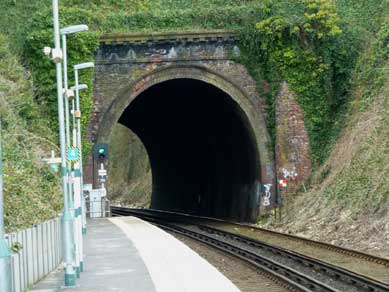
For those who can see over the wall above the tunnel (from Ditchling Road opposite the BP Garage), there is a birds-eye view of London Road Station and its staggered platforms extending to the train sheds on the other side of the listed viaduct.
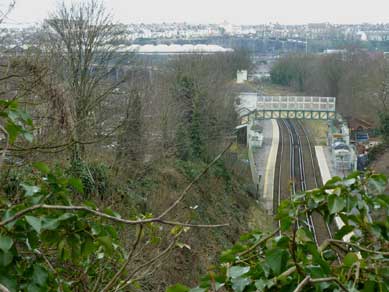
The slight curve before the tunnel brings trains approaching from the east into the view of waiting passengers at the very last minute.

To the west, the track curves once again across the listed London Road Viaduct (one of our city’s best heritage assets) before it joins near the train sheds to the mainline from London to Brighton.

Both a footbridge and a subway connect the platforms of London Road Station.

Though not the original 1889 construction, the footbridge also doubles as a public right of way, connecting two neighbourhoods.

Preston Park conservation area to the north

and Ditchling Rise & Area community to the south

How does the nominated asset meet
the criteria for Communal Value?
As well as directly serving Preston Park ward and Ditchling Rise & Area community, London Road Station also serves London Road (to the south), Round Hill (to the east), The Golden Triangle / Blakers Park area and parts of Hollingdean (further to the north).
Still well known to Brighton’s Railway Mission in Viaduct Road, London Road Station was also meeting-place for many years of a model railway club steeped in local railway history.
There is certainly still recognition by both Preston Park and Ditchling Rise Area residents of the amenity value of London Road Station and its beautiful setting.
Community campaign group FLORA (Friends of London Road Old Railway Allotments) and Preston Park Ward Councillor Amy Kennedy took part in a public inquiry to defend the setting of London Road Station from unsuitable residential development.
No site-specific open space assessment was done (compliant with PPG17 Diagram 1) from the outset when the greenfield site and valued open space behind no.s 67-81 Princes Road Brighton became the subject of a redevelopment proposal (BH2004/03605/FP), nor was there any attempt to follow the processes involving the local community then set out in PPG17 Diagram 1 over seven subsequent proposals involving this railway corridor site. Consequently when a planning committee turned down a proposal to develop the railway corridor plot opposite London Road Station (land to the rear of 140-146 Springfield Rd), it was easy for the developer win an appeal on the basis that permission had been given for an equivalent number of houses behind no.s 67-81 Princes Road. The planning inspector noted that it had not been important to The Council to do site-specific PPG17-compliant open space assessment to defend one railway corridor site, so why should it pretend its open spaces policy was any more robust than already demonstrated to protect another privately owned open space adjacent to the same railway line?

Community garden at London Road Station
Since May 2011, London Road Station has been the site of a community garden, run as a community partnership.

The London Road Station community partnership comprises both Southern Rail and local residents.

London Road Station Partnership’s website is at
http://londonrdstationpartnership.wordpress.com
The community garden is on two plots (previously waste) either side of the station building. The gated plot contains raised beds for growing edible plants including a mini-orchard formed of old Sussex varieties of apples and pears, cordoned up the wall.

The ‘shady triangle’ plot, next to the west exit, contains shade-loving perennials, bulbs and shrubs. Most of the permanent plants have been propagated from neighbours’ and friends’ gardens.

Big Dig week
On Tuesday 19th March 2013, London Road Station took part in Big Dig Week.
How does the nominated asset meet the criteria for Rarity and Representativeness?
Though aspects of what was a standard design in the 1870s are replicated in Hove and Portslade Stations (both already listed), the latter cannot boast the same setting (of Ditchling Rise and Springfield Road) where so many period-architecture features (e.g. fenestration, detailing) remains intact. London Road Station also offers a charming section of railway corridor, fit to be a greenway, even if that designation has proved to be somewhat elusive.
London Road Station remains our city’s most pleasant surviving examples of the Italianate style favoured by the railway architects of the mid Victorian era. The proximity of the listed London Road viaduct, part of the setting of London Road Station, makes this site’s own listing long overdue.
How does the nominated asset meet the criteria for Intactness?
The pictures show that the most important station building – the ticket office and adjoining rooms occupying 2-storeys are largely intact. The fenestration and detailing are original and the Italianate style on the approach from the south (steep flight of steps and balconies) is still clear.
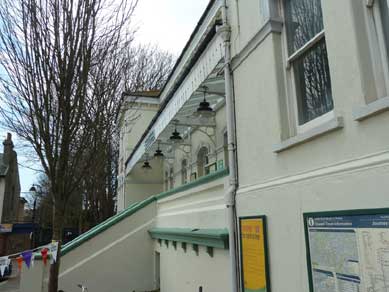
London Road Station is fortunately sited - its setting remains remarkably intact.
The building also retains its original use. Two thriving universities (Brighton and Sussex) and a new football stadium (The Amex at Falmer) guarantee its use as a railway station.
In the documents you have uploaded, have photographs been included? Yes
Do you consent to the council reproducing these photographs in the Local List and associated material?
Yes, all except for the two photos which are not my own from The Kemp Town Branch Line © 1999 (Peter A Harding and Lens of Sutton) ISBN 0 9523458 4 6
Are the photographs taken from public or private land?
Public
END OF NOMINATION
for London Road Station to be added to Brighton & Hove’s Local List of Heritage Assets (March 2013).
Response to application for Heritage Status
of LONDON ROAD STATION by
Return to Main History Section.
This page was last updated by Ted on 07-Feb-2025